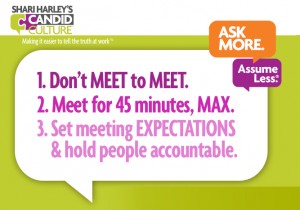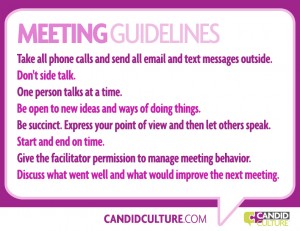Posts Tagged ‘give feedback’
For the most part, people are afraid to speak up at work. Despite the town hall meetings and roundtable discussions executives host, the feedback training offered, the existence of ask-the-CEO email addresses and blogs, and employee satisfaction and engagement surveys, many employees are still afraid to give feedback at work, citing fear of damaging relationships, being fired, and other forms of retaliation.
Those of you who have worked with me, read How to Say Anything to Anyone, and/or used our tools, know that I am on a quest to make it easier to tell the truth at work.
The Candid Culture Vision:
- Coworkers, leaders, and managers set clear expectations before problems occur. No one has to guess what is expected of them and what a good job looks like.
- Employees ask for and receive regular, balanced and candid feedback and always know where they stand performance wise.
- Managers and leaders are open to and ask for feedback. They always know what’s really happening in the organization and can lead accordingly.
- People talk to each other versus about each other. Gossip and drama is the exception, not the norm.
- Work is a fun place to be. People enjoy working together and produce their best work.
Many of you are taking actions to create the environment I’ve described above. I want to hear from you and want to use this blog to share practices for creating more candid communication at work.

Add a comment and tell us:
- What you are doing to increase the trust and communication in your organization.
- The avenues you are using to give feedback on your team, in your department, or in your entire organization.
We’ll enter you to win 50 of our new door tags. The door tags were designed to tell your coworkers that your office is a place they can speak freely, without concern.
 Most of us grapple with whether or not we should give feedback when someone else does or says something frustrating.
Most of us grapple with whether or not we should give feedback when someone else does or says something frustrating.
Here are a few criteria to help you decide whether or not you should give feedback or say nothing:
- Do you have a relationship with the person? Do you know each other well enough to share your opinion? Aka, have you earned the right?
- Has the other person requested your opinion? Unsolicited feedback often goes on deaf ears.
- If the other person has not requested your opinion, does he appear open to hearing feedback?
- Are you trying to make a difference for the other person or just make him look or feel badly?
- Do you want to strengthen the relationship?
Before you give feedback, do something I call, ‘check your motives at the door.’ If your motives are pure – you want to strengthen the person or the relationship, and you have a good enough relationship that you’ve earned the right to speak up — then do it.
People are more open to feedback when they trust our motives. If we have a good relationship with the person and he knows we’re speaking up to make a difference for him or for the relationship, you’ll be able to say way more than if your motives are questionable – aka you want to be right.

 You get an email that annoys you, hit reply, type up your thoughts, hit send and feel instant regret. We’ve all done this. We’re frustrated and we let the other person know.
You get an email that annoys you, hit reply, type up your thoughts, hit send and feel instant regret. We’ve all done this. We’re frustrated and we let the other person know.
Feedback via email is always a bad idea. You don’t know how the recipient will read and interpret your message. You can’t manage the tone of the message or give the person a chance to respond. And more often than not, he’ll reply equally frustrated. And now the non-conversation begins –back and forth, back and forth.
Email is for wimps and voicemail isn’t any better! No texting either. End the madness and pick up the phone or swing by someone’s desk. Things are resolved most quickly and easily by talking about them.
I’m consistently surprised at how much feedback is delivered via email. And I’ll admit to occasionally being guilty of it too. I’m in a hurry or on a plane, and I want something to get done quickly. Or my emotions get the best of me, and I feel compelled to respond to a situation quickly. So I send an email or a text message that I know I shouldn’t send. Then I regret it and spend the rest of the day apologizing and feeling badly for communicating impulsively.
If we want people to want to work with us and perform, we need to consider how our actions impact them. Yes, it’s easier to send a quick email or text. But it invariably annoys the other person and damages your relationships. People can work with you, around you, and against you. If people want to work with you, they’ll work harder and produce better work.
Never underestimate the human ego, which is easily bruised. You are ALWAYS dealing with someone’s ego. The ego needs to be seen as good. When someone (anyone) calls our competence into question, we get defensive. Becoming defensive when receiving negative feedback or when someone questions us is a gut reaction. Not becoming defensive takes a great deal of self-management and is unusual.
Slow down. When you have to give feedback, ask yourself what you want the other person to do. Then ask yourself, how do I need to communicate to get the result I want? Then pause, breathe, and pick up the phone.
 My last few blog posts focused on giving feedback. The posts were designed to help managers get ready to write and deliver performance appraisals.
My last few blog posts focused on giving feedback. The posts were designed to help managers get ready to write and deliver performance appraisals.
Giving feedback will always be hard. No one wants to hear that she isn’t doing a good job, thus no one wants to tell her. Part of the performance appraisal process is setting expectations for the next year. And asking for what you want, before problems happen, will always be easier than giving feedback.
If you’ve seen me speak or attended one of our training programs, you received a list of Candor Questions designed to eliminate the guessing at work. They may have been questions for leaders, managers, strengthening business relationships or managing careers. Regardless of which Candor Question Cards you received, the goal is the same. Ask more. Assume less.
The most frequent request I get is for feedback training. Managers tell me, “The communication in our company isn’t good. Can you help our managers and employees be more candid?” And I tell business leaders, “I teach people to be more comfortable giving feedback. But why start with something hard? Why not start by asking more questions and getting to know people better, which is much easier and will reduce the number of feedback conversations you need to have?”
When we know what people expect, we can give people what they need. We make fewer ‘mistakes’, requiring fewer feedback conversations. So start with what’s easy. Ask more questions.
Start with what I call Introductory Candor Questions:
- How do you like to receive information – email, voicemail or text message?
- Are you a detail-oriented or a big-picture person? How much information do you want to receive and in what format?
- What are your pet peeves at work? What would I do that would be frustrating, and I’d never know it?
Then move on to Candor Questions for Managers:
- What had you choose to work here, and what would make you question that decision?
- What kind of work do you love to do most? What kind of work do you like to do least?
- What do you wish I would start, stop, and continue doing?
You can download samples of our seven types of Candor Questions here.
People are not us and don’t do things the way we do. Don’t assume someone will create a report as you would, participate in a meeting as you would, or dress for an event as you would. Setting expectations before the event of what you want, gives them a chance to be successful.
Giving Feedback is Hard – Asking for What You Want is Easier. By Shari Harley.
The Feedback Formula:
1. Introduce the conversation so feedback recipients know what to expect.
2. Empathize so both the feedback provider and the recipient feel as comfortable as possible.
3. Describe the observed behavior so the recipient can picture a specific, recent example of what you’re referring to. The more specific you are, the less defensive he will be, and the more likely he’ll be to hear you and take corrective action.
4. Sharing the impact or result describes the consequences of the behavior. It’s what happened as a result of the person’s actions.
5. Having some dialogue gives both people a chance to speak and ensures that the conversation is not one-sided. Many feedback conversations are not conversations at all; they’re monologues. One person talks and the other person pretends to listen, while thinking what an idiot you are. Good feedback conversations are dialogues during which the recipient can ask questions, share his point of view, and explore next steps.
6. Make a suggestion or request so the recipient has another way to approach the situation or task in the future. Most feedback conversations tell the person what he did wrong and the impact of the behavior; only rarely do they offer an alternative. Give people the benefit of the doubt. If people knew a better way to do something, they would do it another way.
7. Building an agreement on next steps ensures there is a plan for what the person will do going forward. Too many feedback conversations do not result in behavior change. Agreeing on next steps creates accountability.
8. Say “Thank you” to create closure and to express appreciation for the recipient’s willingness to have a difficult conversation.
If you’re giving more than one piece of feedback during a conversation, address each issue individually. For example, if you need to tell someone that she needs to arrive on time and also check her work for errors, first go through the eight steps in the formula to address lateness. When you’ve discussed an agreement of next steps about being on time, go back to step one and address the errors. But talk about one issue at a time so the person clearly understands what she’s supposed to do.
Here’s how a conversation could sound, using the eight-step Feedback Formula:
Step One: Introduce the conversation.
“John, I need to talk with you.”
Step Two: Empathize.
“This is a little awkward, and it may be uncomfortable. I want you to know that while I wish I didn’t have to tell you this, I’m doing it because I care about you and I want you to be successful.”
Just because you’re direct doesn’t mean you’re not empathetic. But remember, these are my words. You’ll need to find your own words that you feel comfortable using to deliver such a difficult message.
Step Three: Describe the observed behavior.
“John, I’ve noticed that you have an odor.”
Step Four: Share the impact or result of the behavior.
“I know this is a very awkward subject (more empathy). We work in a small space. I don’t want others to avoid working with you or say negative things about you. And as awkward as this is, I would rather you hear this from me than from someone else. Sometimes health conditions can cause certain odors, as can eating certain foods.”
Step Five: Have some dialogue. Ask the recipient for his perception of the situation.
“What are your thoughts?”
Give John time to say whatever he wishes to say.
Step Six: Make a suggestion or request for what to do next time.
“Again, I’m really sorry to have to tell you this. Please make sure you shower every day before coming to work and wash your clothes regularly. And please tell me if there’s something else you’d like me to know.”
Because of the awkwardness of this subject, skip step seven, and go to step eight.
“Thank you for being willing to have this conversation with me.”
You Can Say More Than You Think You Can
You might be gasping, thinking there is no way you could ever tell someone he smells. It’s definitely an awkward conversation, one I hope you never have to have. I used one of the most difficult things you will ever have to say to demonstrate that even the most awkward feedback can be delivered empathetically and quickly.
The short and concise body-odor conversation is a lot less uncomfortable for the recipient than the drawn-out, evasive first version. Just think, would you rather listen to someone tell you that you smell for two minutes or for twenty?
You may also think, “I shouldn’t have to tell someone to take a shower and wash their clothes.” That’s true, you shouldn’t. But if you’re working with someone who doesn’t do these things, clearly someone needs to tell him. Remember, other people are not you and don’t do things the way you do, even when those things appear to be no-brainer basics.
Lastly, you may think that telling someone to shower and wash his clothes is insulting and demeaning. It’s true: No matter how you spin it, there’s nothing nice about this message. But which is worse, having your coworkers ask for different desks and be unwilling to work with you, or having someone who has your best interests at heart tell you privately to clean it up—quite literally? When you tell people the truth, you do them a favor.
Here’s another example: A few years ago I had a coworker who was a lingerer. Lisa would hover outside my office until she saw an opportunity to interrupt. She then walked in uninvited and started talking. I was still mid-thought about whatever I’d been working on and wasn’t ready to listen. After a few sentences, I would interrupt Lisa, saying, “I’m sorry. I don’t know what you’re talking about. Will you please start over?”
Embarrassing as it sounds, this went on for more than a year. I wanted to be seen as accessible and open, yet this “lingering” method of interrupting was driving me crazy. And it was a waste of both of our time. After many months of frustration, I decided to use the eight-step Formula.
Step One: Introduce the conversation.
“Lisa, I want to talk about something I’ve noticed.”
Step Two: Empathize.
“I probably should have said something a long time ago. I’m sorry I didn’t.”
Step Three: Describe the observed behavior.
“I’ve noticed that when you want to talk to me you stand at my door, waiting for a good time to interrupt. When you come into my office, you’re often in the middle of a thought or problem that you’ve probably been thinking about for a while.”
Steps Four and Six: Share the impact or result of the behavior and make a suggestion or request for what to do next time.
“Because I’m in the middle of something completely different, it takes me a few seconds to catch up. By the time I have, I’ve missed key points about your question and I have to ask you to start over. This isn’t a good use of either of our time.
“Here is my request: When I’m in my office working and you need something, knock and ask if it’s a good time. If it is, I’ll say yes. Give me a few seconds to finish whatever I’m working on, so I’m focused on you when we start talking. I’ll tell you when I’m ready. Then start at the beginning, giving me a little background, so I have some context. And if it isn’t a good time for me, I’ll tell you that and come find you as soon as I can.”
Step Five: Have some dialogue. Allow the recipient to say whatever she needs to say.
“What do you think?”
Step Seven: Agree on next steps.
“Okay, so next time you want to talk with me, you’re going to tap on the door and ask if it’s a good time to talk. If it’s not, I’ll tell you that and come find you as soon as I can. If it is a good time, you’re going to give me a second to finish whatever I’m working on and give me some background about the issue at hand. Does that work for you?”
We have just managed “the lingerer”—a challenge you probably have, unless you work from home or in a closet.
You may have noticed that I changed the order of the Feedback Formula during this conversation. It’s not the order of the conversation that’s important. It’s that you provide specific feedback, offer alternative actions, and have some dialogue before the conversation ends.
Summary: Good Feedback Is Specific, Succinct, and Direct.
Provided you have a trusting relationship with someone and have secured permission to give feedback, there is very little you can’t say in two minutes or less. The shorter and more direct the message, the easier it is to hear and act upon. Follow the eight-step Feedback Formula. Be empathetic and direct. Cite specific examples. Give the other person a chance to talk. Come to agreement about next steps. Remember, you do people a favor by being honest with them. People may not like what you have to say, but they will invariably thank you for being candid.
This week’s blog is an excerpt from my book How to Say Anything to Anyone: A Guide for Building Business Relationships That Really Work. I hope it helps you have the conversations you need to have! Be candid. You can do it!
 Giving negative feedback is hard. Asking for what you want will always be easier.
Giving negative feedback is hard. Asking for what you want will always be easier.
Set Expectations That Are Clear
We have all worked hard on a project, only to find out that what we created is not what our manager was expecting. When this happens, everyone is frustrated. Managers question whether or not employees listen. Employees wonder why managers who want something specific didn’t just say so when the work was assigned.
Managers would be well served by setting clear expectations at the beginning of working relationships and projects. Tell your employees what a good job looks like. Don’t make them guess.
If you want a weekly status update, tell employees that rather than being frustrated when you don’t know where projects stand. If you want a bulleted summary, tell people that rather than being annoyed when five paragraphs land in your inbox. If you envision a report with tables and charts, tell employees that versus being disappointed when they create a bulleted list.
Most of us assume people will do things the way we do. They won’t. Save time and reduce frustration by being crystal clear when you set expectations at the beginning of anything new.
When people see the title of my book How to Say Anything to Anyone, they think it’s a book about giving feedback and having difficult conversations. It’s not. How to Say Anything to Anyone is about asking more questions, so you know what your direct supervisor, coworkers, and customers need and don’t have to guess. How to Say Anything to Anyone is not about giving people bad news. It is about asking for what you want before challenges occur, and then talking about how you’ll deal with challenges when they arise.
If you work for someone who does not set expectations that are clear, then you, the employee, needs to set those expectations.
Set expectations by asking your manager:
• When do you want to see this, in what format, with how much detail?
• What does a good job look like?
• What’s your expectation of how this should look when it’s complete?
• Where does this fit, as a priority, in relation to other projects?
• How does this project fit into the department’s or organization’s goals?
Asking questions and telling people what you want is always easier than giving negative feedback. Everyone – employees and managers alike – are accountable for ensuring that the set expectations are clear and that work is done right the first time Ask more. Assume less.
Download the five questions managers must ask their employees to set expectations that are clear:
 Meetings go long. Attendees stealthily text under the table like no one can see them. One person talks the whole time, while everyone else rolls their eyes. The decision maker isn’t there, forcing you to have another meeting. All the while, the facilitator does nothing.
Meetings go long. Attendees stealthily text under the table like no one can see them. One person talks the whole time, while everyone else rolls their eyes. The decision maker isn’t there, forcing you to have another meeting. All the while, the facilitator does nothing.
Sound familiar?
The amount of time wasted in unproductive meetings and the degree of frustration meeting participants feel is astronomical.
The solution is simple.
Set clear meeting expectations at the beginning of EVERY meeting and hold people accountable when they violate the guidelines.
Most meeting facilitators don’t set expectations at the beginning of meetings. Instead they expect attendees to follow the unstated, assumed guidelines. And when the meeting facilitators’ boss, peers or customers are on their phone, it’s too hard to say something. So facilitators ignore the behavior, hoping it will stop without intervention.
The key to getting what you want in meetings (and in life) is to ask, which for the most part, we don’t. We assume people will do things as we do.
Tips for Running a Good Meeting:
1. Set meeting expectations at your next meeting.
2. Write the expectations on a flip chart and hang them up at the beginning of every meeting. Or download our meeting expectations poster and hang it in your conference rooms.

3. Review the meeting expectations every time you meet, even with groups who meet weekly.
4. Ask meeting participants’ permission to manage meeting behavior. Your role as the meeting facilitator gives you the right to address bad meeting behavior. Asking for permission and letting people know you will say something if you see their phone etc., makes it easier to speak up.
5. Tell participants they are expected to hold themselves and each other accountable.
6. Then hold people accountable for following the meeting expectations. If you ask people not to side talk, address side talking when you hear it. If you ask people not to be on their laptops or phones, ask people to put them away. If one person talks too long, interrupt him. You will have no credibility if you set expectations but don’t hold people accountable.
The reason facilitators don’t hold people accountable is that they feel uncomfortable. It’s hard to tell your peers, boss and other coworkers not to talk in circles. It’s almost impossible if you don’t set expectations about meeting behavior and set the expectation that you will say something when the meeting expectations are violated.
The simple act of setting meeting expectations and asking people’s permission to manage to those expectations makes doing so easier. Not easy, but easier. Asking your boss to put her phone away will never be easy, but it will be easier if you let her know BEFORE she pulls it out that you’ll do so.
You may be thinking, “I don’t run these meetings. I’m an innocent victim.”
As a meeting participant it is frustrating to go to poorly run meetings. But it’s also your role to speak up when you see things going poorly. Go to the meeting facilitator and give feedback. If you’re not sure what to say, follow The Feedback Formula outlined in my book How to Say Anything to Anyone.
Express empathy: “That Wednesday team meeting is tough. I wouldn’t want to run it.”
Ask permission to give feedback: “I’ve got a few observations and suggestions. Is it ok if I share them?”
Give feedback: “I’ve noticed that several people have been missing the meeting and others are on their phones and laptops during meetings. This definitely limits what we can get done and must be frustrating to you. What are your thoughts?”
Make a suggestion: “What do you think of setting meeting expectations at the next meeting and then telling people you’re going to hold them accountable?”
Offer help: “You’re not alone in this meeting. I’d be happy to tee up this discussion and explain why we need to set meeting expectations. What do you think?”
The facilitator knows the meetings aren’t going well. She just doesn’t know what to do. Offer to help. Don’t judge. She might be more receptive than you think. And you can stop suffering through poorly run meetings.
 I’m frequently asked the question, “Is there such a thing as too much candor?” Clients ask this question when an employee or coworker is telling anyone who will listen exactly what she thinks of just about everything. Incidents like these make managers and leaders hesitant to ask employees for feedback, not knowing how to turn off the well.
I’m frequently asked the question, “Is there such a thing as too much candor?” Clients ask this question when an employee or coworker is telling anyone who will listen exactly what she thinks of just about everything. Incidents like these make managers and leaders hesitant to ask employees for feedback, not knowing how to turn off the well.
Yes, there can be too much candor. The truth is one ingredient in the recipe; it’s not the whole meal.
A few guidelines of when to give feedback:
1. You have a relationship with the feedback recipient, and he will be able to hear you without becoming overly defensive.
2. You’ve been asked for your opinion.
3. You feel very strongly about an impending decision that has not yet been made.
When not to give feedback:
1. The feedback recipient can’t change what you’re concerned about.
- If you’re concerned about a policy that isn’t changing, expressing an opinion is just complaining, which will negatively impact your reputation.
- The person you have feedback for can’t change that aspect of herself. For example, you comment that someone has a high, squeaky voice. That’s just an insult. And an insult isn’t feedback, no matter how hard you try to persuade yourself otherwise.
2. You don’t have a relationship with the feedback recipient and thus your message is likely to go on deaf ears.
3. You have not been asked for your opinion.
4. A decision has been made and at that point you’d just be talking to talk.
When managers ask me, “Is there such a thing as too much candor,” I suspect what they’re really asking me is, “How do I get my employees to be more discerning with the feedback they share, to whom, and how.”
Here are a few ways to guide employees who over communicate:
1. When you ask for feedback, tell people specifically on what you want feedback, in what format, and during what time horizon.
For example, tell employees, “We are looking for feedback on the new time-off policy. We’ll be asking for input at Friday’s town hall meeting. Please come to the meeting and share your thoughts. This will be the only opportunity to provide input.”
2. Tell employees who have a tendency to overwhelm with feedback or violate some of the guidelines listed above, “Your input is valuable. The more feedback you give, the harder it is to discern what’s important. Pick your battles. Give feedback on the things you feel really strongly about, and perhaps save other feedback for future opportunities.”
3. Tell employees who have a tendency to insult people with critical feedback, “How you deliver feedback influences whether or not people can hear your feedback and take action. No one likes to be told that she is wrong. Be careful not to attack people. Focus on the problem, not the person. Ask questions and make requests versus telling someone why what she is doing is wrong. Then, of course, tell the person to read chapters nine through twelve of my book How to Say Anything to Anyone.
Just because you can say something, doesn’t mean you should. None of us wants to damage relationships by insulting people or be labeled as a complainer. Pick your battles. Give feedback when you feel really strongly, a final decision has not been made, and you have a relationship with the recipient. And if you find yourself talking to talk, stop.
I received lots of emails last week about performance appraisals gone wrong. Some made me sad. Some made me sigh. And the ‘best of’ the worst was so outlandish it made me laugh out loud. Really laugh out loud. Not that LOL thing we overuse.
The ‘best of’ the worst examples of performance appraisals are below.
Bad example #1: Giving mixed messages.
• Giving an employee working on a long project gift cards as a reward and then during the performance appraisal telling her she did the whole project wrong and had to start over.
Bad example #2: Waiting too long to give feedback.
• Giving an employee a performance appraisal six months late.
Bad example #3: Being lazy.
• Using the employee’s self appraisal as the final appraisal, without the manager adding any of his or her own comments.
Bad example #4: Never awarding the highest rating possible, to anyone.
• If a one is the best rating and a five is the worst rating, no one ever earns a one.
Bad example #5: Holding people to expectations and standards but not sharing those expectations.
• Not clarifying at the beginning of the year what the expectations are and what a good job looks like.
Bad example #6: Never giving employees feedback about their performance.
• Writing performance appraisals and documenting performance issues, but giving none of the written or verbal feedback to the employee.
Bad example #7: Giving small amounts of vague feedback.
• Giving little to no data in the review because the manager didn’t work closely enough with the employee to observe performance directly and didn’t ask others in the organization to provide feedback.
Bad example #8 (I received this example SEVERAL times): Providing only a written appraisal.
• Handing an employee a written appraisal while in a meeting with other people and never having a conversation.
This is just hilarious:
“During my annual performance appraisal I was asked if I was manic. After a moment or two of trying to understand what my supervisor meant by the comment, I finally asked. My supervisor replied, “Well, you are so upbeat about your job all the time, I just thought you were manic. Nobody can be that happy about working here.””
The winner for being the ‘best of’ the worst:
My manager tossed my performance appraisal on my desk saying, “Just look this over and sign it. I want it back by the end of the day.” Of course, the appraisal was full of feedback and expectations that I had never received.
I told my manager, “There is a lot of information here that was never discussed with me. I would have liked the opportunity to discuss these issues before it showed up in my review.”
The manager replied, “See this is why I didn’t want to meet with you! I knew you would react badly! Just man up, take the feedback, and sign the thing! It’s due to HR today.”
You can’t make this stuff up.
Managers: If you do a little better than these ten examples of performance appraisals, you’re outperforming your manager peers. Sad but true.
Employees: You are responsible for your career happiness, success, and satisfaction, not your boss. Ask for expectations at the beginning of anything new and for regular feedback.
Take your performance into your own hands:
1. Don’t wait for your boss to set expectations. Ask your boss for his/her expectations. Get very clear on what a good job looks like, before you start working on a project and/or when the year starts.
2. Write annual goals and review them with your direct supervisor at least quarterly. During your regular one-on-ones, ask for feedback. If you don’t have regular one-on-ones, start. Ask your boss’s permission to schedule a one-on-one at least quarterly to update him/her on projects and to gather feedback.
3. Ask for regular feedback on pieces of work as you complete the work. Don’t wait until the end of a project to get feedback.
4. Ask for feedback about your overall performance once a quarter.
Ask these questions:
• How am I doing so far this year performance wise?
• What mistakes have I made from which I need to recover?
• What aspects of my work have contributed most to the organization?
• What do I need to do between now and the end of the year to ensure a positive performance appraisal?
The performance appraisal system doesn’t have to be rife with challenge and lead to disappointment. Take more control over your conversations and thus your outcomes.
A few weeks ago a fellow business owner told me about one of his employees whose performance had dropped. The work she was producing was acceptable but not as good she had done in the past and not as good as he knew she was capable of doing. So he asked her to rate her performance.
He asked his employee, “If you had to rate the level of work you’re producing, how engaged you are in your job, and how committed you are to the company, how would you rate yourself?” The employee thought about her manager’s question and replied with a score of 65%. He asked why she wasn’t giving the job 100% of her effort and ability. She said she didn’t know.
We all have times when we coast and do our minimal best. Sometimes we’re tired and need a break, or don’t like the type of work we’re doing, or don’t like the people we’re working for or with. Those are typical reasons for producing so-so work or having a moderate level of commitment to a company or job.
But sometimes none of those things are at play. We’ve just become complacent.
Evaluate where you are today in your level of commitment to and interest in your job. What score would you give yourself? If you’re not giving 100%, why not?
If you rated yourself below 100% ask yourself these questions:
- Do you like the work you’re doing?
- Are you bored?
- Do you care about the work you’re doing or the work the company does?
- Do you like who you work with and for?
- When’s the last time you took time off? Really took time off, without checking email.
If your performance and level of commitment is less than you know you’re capable of doing, and your performance level is related to the questions above, have a conversation with someone in your organization who can help you do something about those things. Things won’t get better without your intervention.
If you’re not sure how to ask for more or different work, read my new book How to Say Anything to Anyone and get the language you need to have this conversation. The book won’t be in bookstores or available on Amazon until January, but we have some advanced copies for our clients.
If there are no issues to address, ask yourself if you’ve just gotten complacent. Have you gotten into the habit of coasting and delivering work that’s not at the level you’re capable of doing, for no particular reason? If that’s the case, recommit to checking back in and raising your performance –just because you can.
Why not be awesome?



 Most of us grapple with whether or not we should give feedback when someone else does or says something frustrating.
Most of us grapple with whether or not we should give feedback when someone else does or says something frustrating.
 You get an email that annoys you, hit reply, type up your thoughts, hit send and feel instant regret. We’ve all done this. We’re frustrated and we let the other person know.
You get an email that annoys you, hit reply, type up your thoughts, hit send and feel instant regret. We’ve all done this. We’re frustrated and we let the other person know. My last few blog posts focused on giving feedback. The posts were designed to help managers get ready to write and deliver performance appraisals.
My last few blog posts focused on giving feedback. The posts were designed to help managers get ready to write and deliver performance appraisals. Giving negative feedback is hard. Asking for what you want will always be easier.
Giving negative feedback is hard. Asking for what you want will always be easier.
 Meetings go long. Attendees stealthily text under the table like no one can see them. One person talks the whole time, while everyone else rolls their eyes. The decision maker isn’t there, forcing you to have another meeting. All the while, the facilitator does nothing.
Meetings go long. Attendees stealthily text under the table like no one can see them. One person talks the whole time, while everyone else rolls their eyes. The decision maker isn’t there, forcing you to have another meeting. All the while, the facilitator does nothing.

